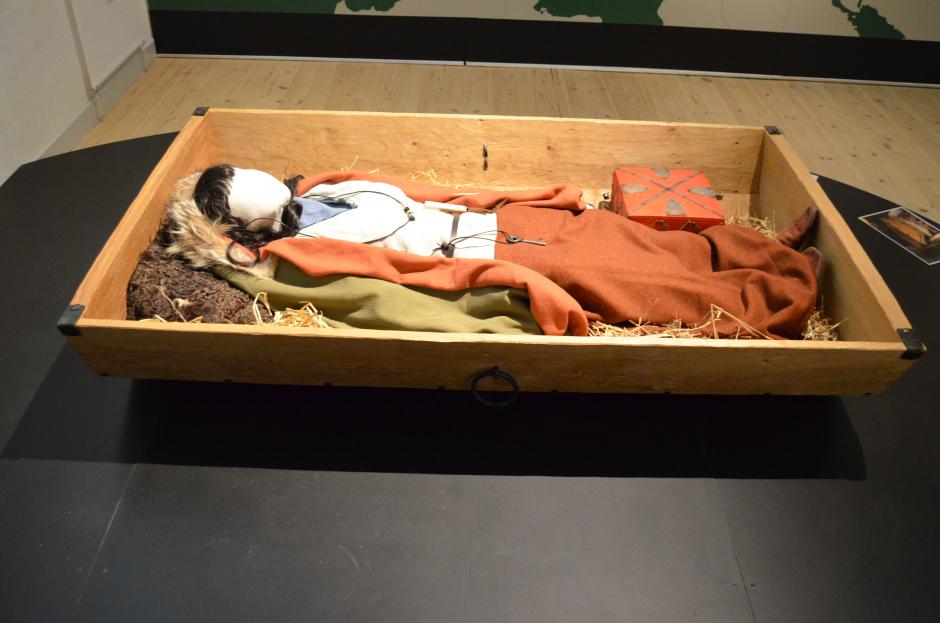“It’s very special that the man and woman’s graves are marked by the same tomb or palisade. It’s unusual that we’re able to establish that the man and woman were equals with such certainty.” – Kirsten Nelleman Nielsen, excavation leader.

PHOTO: sciencenordic.com
HÅRUP, DENMARK – Archaeologists have discovered a unique and highly important Viking burial ground in southwest Denmark.
We know a lot about customary Viking burials from Icelandic sagas, Old Norse poetry, and archaeology. Scandinavia is dotted with burial grounds that honor Viking kings and chieftains. Some of the most notable are the Borre mound cemetary in Norway, Birka in Sweden, and Lindholm Høje in Denmark. Usually the deceased were laid in a boat, and piles of stones and soil were laid on top of the remains, creating what archaeologists call a “tumulus”. Gifts were left for the dead, even if the corpse was burnt on a pyre. The funerals were a significant expense for the family members of the deceased.
Many of the military Viking burials have been female. Sheildmaidens were more common than archaeologists originally thought, according to examinations on the bone structures of the bodies found in Viking burials.
This particular grave was discovered first in 2012. Engineers were just going about their everyday business, working on constructing a highway in southwestern Denmark, when they stumbled across a unique Viking tomb called a dødehus, or, translated: lit. “death house”. The building’s four meters by thirteen meters, and contains three graves that date back to the height of Viking culture, in AD 950, when Erik the Red was founding the first Norse settlement in Greenland, the Maya were collapsing and the Toltecs were rising in Mexico, and Gorm the Old was the first recognized king of Denmark.
The archaeologists working on the site have confirmed that there was a man and a woman buried in the main part, and another man buried in the back of the building. The man buried in the main part of the building was buried with a huge battle axe. It would have been an extremely formidable weapon, the kind that was famous for terrorizing most of Europe. People across the world feared this type of axe, known as the “Dane Axe”. Kirsten Nielsen, who’s in charge of the dig, calls it the “machine gun of the Viking Age”.
The woman was buried in a wagon, like most burials of women of noble birth in this era, and she was buried with her keys. One key is the symbol of the woman’s status and power as a noble lady of the Viking kingdom, the other fits a rare square shrine that this noblewoman was also buried with.
The pair has proved to be a distinguished couple, if the markings on the grave are any indication. They were probably the gentleman and lady of the surrounding area. The items they were buried with and the way the men and woman were laid in the grave suggests they were a very, very powerful couple in Denmark.
The tomb’s special for two reasons. First, the man and the woman’s graves in the main part are marked with the same palisade, allowing the archaeologists and researchers to easily establish that the two were equals with complete certainty. It’s not uncommon for women in the Viking Age to be just as powerful as men. The graves found by archaeologists that contain both men and women from the same status make no distinction between the two. The women are never buried in an inferior fashion to the men. This new grave is no exception.
The other reason it’s special is that the leading archaeologists believe that the builders drew inspiration for its style outside of Scandinavia, possibly from the Baltics. They’ve found Baltic ceramics and silver coins from the area around modern-day Afghanistan, so the residents probably traveled the world far and wide.
The site will continue to be worked on and preserved by Scandinavian researchers and archaeologists. This year, the University of Copenhagen in Denmark released a publication about the find.
“Many of us think that people didn’t move around much in the past. But [the Viking grave] is a good example of how the opposite is true. ” – Kirsten Nelleman Nielsen, excavation leader.
“I don’t know where the myth originated. Plenty of evidence shows that the Vikings had objects from foreign lands. People were hugely mobile in the Viking Age.” – Henriette Lyngstrøm of the University of Copenhagen.

